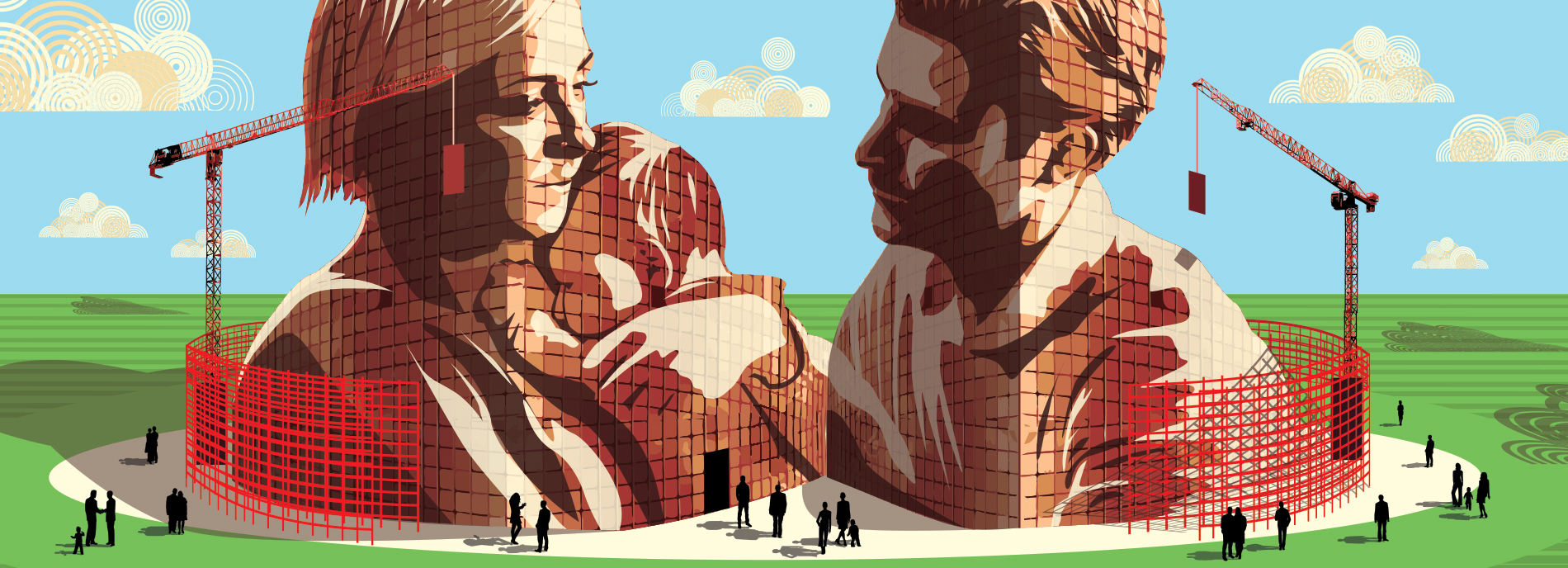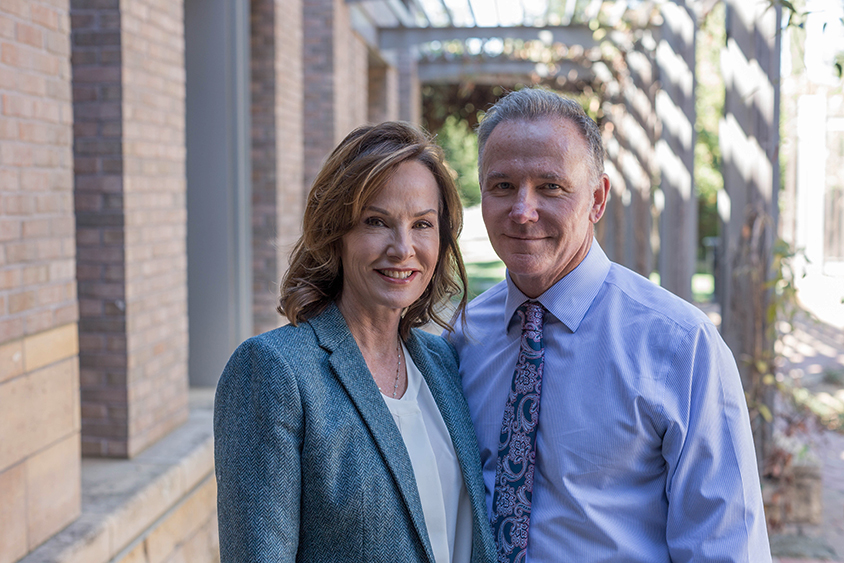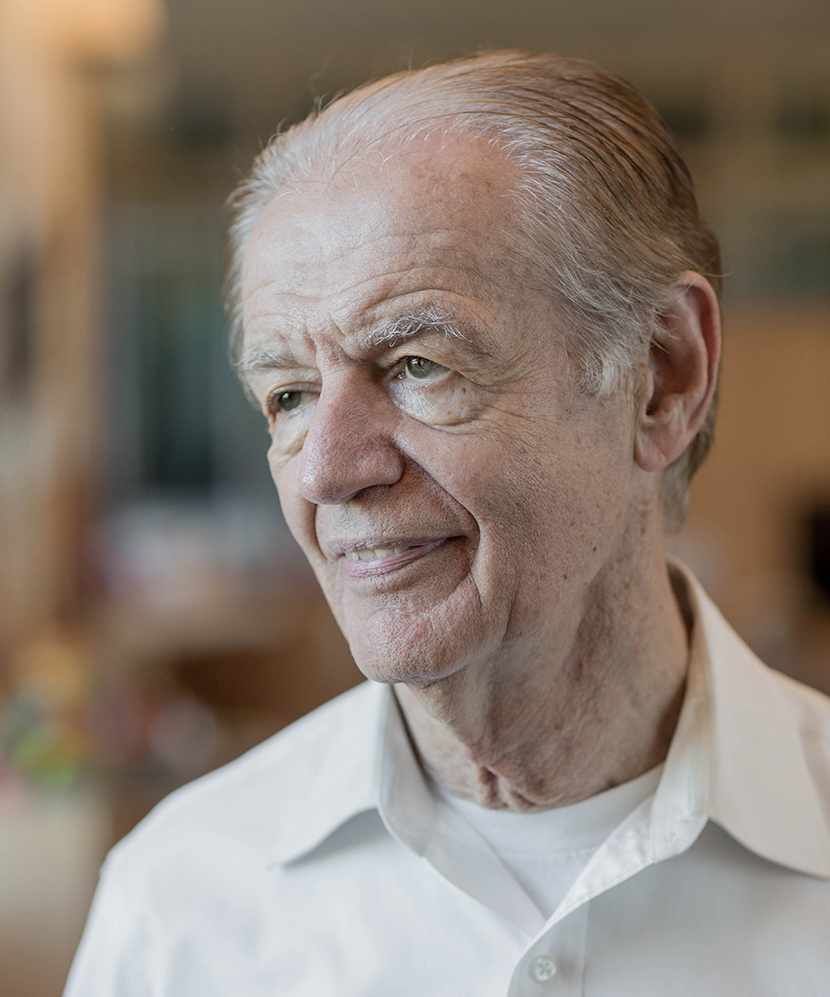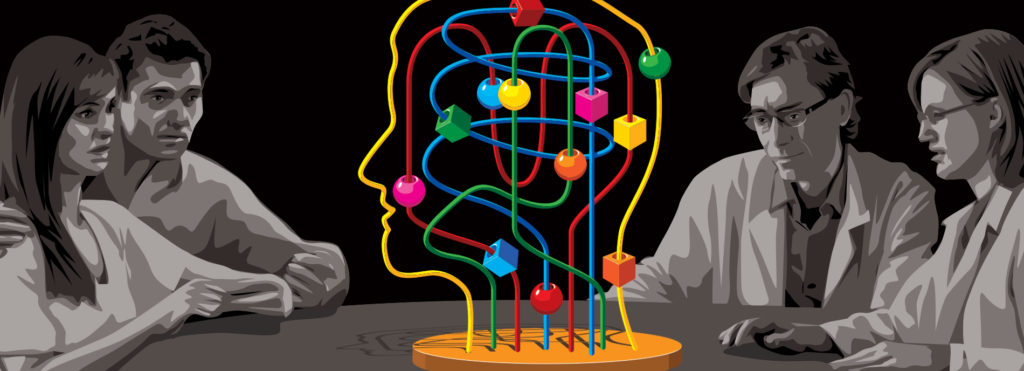Spectrum: Autism Research News
The builders
How parents shaped autism research
A group of savvy parents jump-started autism research in California, but they also set the research agenda.

This is the final article in a four-part series on the unique relationship between researchers and families in the autism community. You can read the previous articles in the series here.
Listen to the Spectrum podcast to hear more from the parents and scientists featured in the Family ties series, as well as the reporters’ experiences behind the scenes:
[powerpress]

For the first time in a long time, Chuck Gardner felt like he could breathe easy.
It was 8 September 2001, and a crowd had turned out to celebrate the groundbreaking of the MIND Institute at the University of California, Davis (UC Davis).
Gardner leaned over and wrapped his arms around his 9-year-old son, Chas, who has autism. Chas was having one of his bad days. The large, noisy gathering was overwhelming for him. His stomach hurt. But on this sunny afternoon, Gardner couldn’t help but feel a little hopeful.
Three other fathers stood or crouched alongside them, each with his own young child. The fathers’ determination to help their sons with autism had spawned five years of meetings and phone calls, fundraising and lobbying. They posed for a picture, then plunged their shovels into the sunbaked Sacramento dirt. In that moment, Gardner thought he and his fellow fathers were doing everything they could to help their children. They had an ambitious goal for the new institute: They wanted a cure for autism.
Nearly two decades after the men first imagined it, the MIND Institute counts among its ranks 55 of the world’s premier scientists working on autism and other neurological conditions. Most researchers are based in two neighboring buildings on campus; the rest are scattered in departments across the university. MIND has research grants and contracts that total about $25 million annually, the majority of them from the National Institutes of Health (NIH). The state of California kicks in about $2.7 million a year.
Over the years, the institute’s researchers have made major discoveries in the fields of neuroscience, immunology, behavioral and language interventions, environmental toxicology and targeted treatments. “MIND and the investigators that are present there have been central to most of the significant developments within autism research within the last decade or so,” says Mathew Pletcher, interim chief science officer for the advocacy organization Autism Speaks.
What sets MIND apart, he and others say, has been its focus on collaboration: between experts from different disciplines, with other universities, and between researchers, clinicians and families. This type of integration was part of the institute’s founding vision.
Families have driven research fundraising for a host of childhood conditions. This is hardly surprising; nothing motivates parents like seeing their children suffer. In the 1990s, as autism diagnoses were accelerating but research funding remained sparse, parent-led research efforts emerged en force.
The small cadre of parents who formed MIND were especially well positioned. By the time their young sons were diagnosed with severe autism, many were community leaders in Sacramento, California’s state capital. They used their connections, influence, skill and passion to amass funding and political support for the new institute. Their vision influenced everything from the organization’s research agenda to the color of its walls.
In the early years, these parents sat on grant evaluation panels, helping to decide which pilot research proposals would be funded. They pushed for the creation of the International Meeting for Autism Research, which today brings together more than 2,000 researchers, advocates and family members from around the world. But their early goal for the institute — finding a ‘cure’ for their children’s autism — has become increasingly controversial.
“The moment you walk through the front door, it’s like somebody’s embraced you.” Sarah Gardner
Down payment:
In the spring of 1996, Gardner and his wife Sarah were exhausted. She anchored the evening newscasts on a local Sacramento TV station, KCRA; he managed construction projects. They had a new baby and 4-year-old Chas, who had been diagnosed with autism two years earlier. For years, it seemed, little Chas had gotten by with almost no sleep. He was in constant motion, running around and getting into things he shouldn’t. He threw epic tantrums, wailing and screaming. His parents suspected he suffered from terrible stomach pain, though he had no words to explain it.
Chuck Gardner had been trying to gather information to help his son since Chas was first diagnosed in 1994. There wasn’t much out there. The first time he typed “autism” into a search engine on his computer, it garnered just 300 hits. He and Chas flew all over the country to see specialists, but those trips were exhausting, even disastrous. In one Chicago neurologist’s waiting room, Chas tried to climb the metal halo that splinted a man’s broken neck.
One day, as Gardner was driving by the UC Davis Center for Neuroscience, he had a thought: Maybe those scientists would be interested in his son’s perplexing situation. He sat down with his friend Rick Hayes, a fellow board member of a group called Families for Early Autism Treatment. Hayes’ background was in marketing. His son also has autism. The two men tried to apply the thought processes they used in their respective lines of work to answer a new question: How would one cure autism?
They mapped out a path, beginning with a plan to understand the basic biology of autism. They called it Project Hope.

Building hope: Sarah and Chuck Gardner stand outside the MIND Institute, which they helped found and fund.
Photography by Jonathan Sprague
Through a friend, the Gardners arranged to have dinner with the dean of the UC Davis School of Medicine. The dean was interested enough in their ideas to call a meeting with other department heads. Chuck Gardner remembers standing at that meeting, outlining his plan to search for both a biological cause and cure for autism.
“They were giving me this blank look,” he recalls. “I stopped talking and said, ‘What’s the problem?’ They said, ‘You need money.’”
“How much?” he asked. Someone threw out a figure: $3 million.
As a down payment on helping his son and other children with autism, Gardner thought, that sounded like a bargain.
At an autism conference in downtown Sacramento in 1997, he met with a prominent local cardiologist, Lou Vismara, whose youngest son, Mark, had been diagnosed with autism in 1995. At that time, a stigma persisted around the condition, left over from 1940s theories suggesting autism was caused by ‘refrigerator mothers’ who didn’t show their children enough warmth. Vismara and his family initially felt so wary of what people would think that they kept Mark’s diagnosis secret. But that “bunker mentality” had worn on them.
By the time Gardner met Vismara, the doctor was ready to act. He had saved the lives of a lot of wealthy people; now he was prepared to ask for their help.
With Vismara reaching out to his contacts, the fundraising quickly gained momentum. Vismara’s dear friend, a powerful local developer named Angelo Tsakopoulos, contributed half a million dollars. Steve Beneto, a West Sacramento trucking magnate whose adult son has autism, contributed another half a million. The Massie family contributed $1 million. Vismara himself donated $250,000. Many of those donors contributed far more as the years went on.
Vismara pushed to expand the mission for the new institute to include other brain conditions. That would open up more funding streams, he thought. As a cardiologist, he had seen all sorts of advances in the understanding of the heart. Shouldn’t their goal be to gain a better overall understanding, not just of autism, but of the human brain?
Within a year, the families had raised nearly $6 million. Luck and timing were on their side: California had a big state budget surplus, and one of the founding parents, Rick Rollens, was a former secretary of the California Senate. Joseph Silva, who served as the dean of the UC Davis School of Medicine at that time, describes Rollens as “a guy who doesn’t really take ‘no’ for an answer.”
“He drove it really hard,” Silva says.
In August 1998, the state allocated $2 million a year to the new institute. Two years later, the governor, Gray Davis, approved $30 million that helped finance two buildings for what would become the Medical Investigation of Neurodevelopmental Disorders (MIND) Institute.
MIND’s creation was part of a groundswell of parent-driven autism research. Appalled at how little federal and private funding was available, Karen and Eric London had founded the National Alliance for Autism Research in 1995 in New Jersey. Around the same time, Portia Iversen and her husband, Jonathan Shestack, launched Cure Autism Now, which grew into a national network of parents and clinicians headquartered in Los Angeles. The two organizations were rivals for a time. They eventually each merged with Autism Speaks.
Vismara says that, with so little funding for autism research, parents had no choice but to take matters into their own hands. He remembers contacting one autism researcher, Isabelle Rapin, after he read her 1997 review article in The New England Journal of Medicine. He asked to speak to her assistant. She laughed and told him, “I’m in the basement, working by myself.”
Team spirit:
Walking into the MIND Institute, it is easy to spot the influence of the founding parents. The paintings that dot the walls — beaches, cityscapes, abstract figures — were all created by people with disabilities. The clinic has a relaxed, quiet feel: It features small, semi-private waiting areas and a playground where children can burn off energy while they wait. The walls are painted earthy and soothing colors.
Gardner helped design the new building. He had spent enough time dragging Chas to doctors’ offices to know what didn’t work: flickering fluorescent lights, vinyl floors, harsh colors, cramped waiting rooms filled with too many people and objects that a hyperactive child could easily break. He and the architects used to joke that everything from the aquariums to the walls needed to be “Chas-proof.”
Beyond making MIND a welcoming place for families, he and the other parents were determined to make the space conducive to collaboration. Early on, Gardner made calls to researchers around the country: “It became really clear to me that they didn’t talk to each other,” he says. He was appalled to realize that meant scientists were unknowingly duplicating each other’s efforts.
The institute has one main entrance and a café, both intentional design features that allow researchers from different labs to bump into each other and chat. The inclusion of a clinic ensures that researchers regularly interact with children and families affected by autism. The inverse is also true: Children and families can see the researchers who are working to help them.
David Amaral, a psychologist and neuroscientist, came on as research director in 1998. Although the buildings that housed MIND wouldn’t be complete for a few more years, he was in charge of creating a team of scientists. At the time, he was the university’s sole autism researcher. And, even for him, it was more of a side pursuit. The fact that there was no one on campus focused on autism was actually a big asset, he says. He was able to recruit scientists from all over the country to build the multidisciplinary, highly interactive team the founding parents had envisioned.
Randi Hagerman, a pediatrician and expert on the treatment of fragile X syndrome, a genetic condition that can cause a range of developmental disabilities, moved from the University of Colorado in Denver to become MIND’s executive director. David Hessl, who arrived from Stanford University in 2002 to continue his research on behavioral neurogenetics and fragile X, recalls the excitement of being involved in something brand new. “It sort of felt like the sky was the limit,” he recalls. “I could go in whatever direction I wanted to” rather than trying to fit into a research program that was already underway.
Early on, the founding families helped steer some of the areas of inquiry. For the first five years, a parent joined the scientists on the five- or six-person advisory board that decided which grant proposals to fund. The founding parents wanted the institute to consider new areas of research, especially in the realms of environmental and immune causes of autism. Specifically, Amaral says, they wanted research that was going to lead to treatments and a cure. “They had this laser focus and kept encouraging us to go in that direction,” he says.
He recalls one application from a scientist who wanted to study the impact of having a child with autism on family life. The proposal was well written, but the parent on the committee argued strenuously against it because it wasn’t integral to finding a cure. Amaral says the project was not funded.
Gardner recollects sitting on a committee evaluating a grant for Judy Van de Water to work on the effects of a pregnant woman’s immune response on her fetus. His job was not to understand the science, he says, but to provide feedback on the ideas. He thought studying the immune system was key to understanding autism; he felt Van de Water was onto something, and said so.
Someone on the committee expressed a worry that the project was “a fishing expedition,” he recalls.
“Is it good science or not?” Gardner asked.
“Yes,” came the answer, the science was sound.
“Well, I think we’re fishing in the right spot,” Gardner said. “Let’s approve this one.” Van de Water’s project received $50,000.
On rare occasions, tensions emerged between certain families and scientists. Rollens was, and remains, a big believer that vaccines cause autism, despite strong scientific consensus to the contrary. Not all of the other families agreed, but Rollens and his wife felt they had seen a dramatic change in their son, Russell, around the time he was vaccinated. Rollens wanted scientists at MIND to investigate his belief.
Amaral says he looked into commissioning a study on the vaccine-autism link, and determined that there simply was not adequate long-term data in the United States to carry one out. MIND did not have the financial resources to collect such data, he says, and other evidence he reviewed seemed to indicate that no such link exists. He explained this to Rollens, who voiced his disappointment.
“We decided to agree to disagree,” Amaral says. Today, Amaral says, he is more convinced than ever that vaccines do not cause autism. He does, however, emphasize that MIND has made important strides in studying the role of the immune system in autism.
“The parents gave us a mission; that’s deeply embedded in our culture.” David Amaral
On a mission:
The families’ strong interest in the biology of autism meant that certain areas of inquiry at MIND could seem out of step with the scientific mainstream. Van de Water’s work was initially greeted with some skepticism because it did not fit with mainstream scientific beliefs at the time. Today, Van de Water says, many people take that same once-controversial connection for granted.
More recently, some scientists have questioned her partnership with a diagnostic company — founded by Gardner — intended to develop a test for maternal antibodies that would predict autism in a child. The critics worry that tests like this are premature and ineffective. Van de Water says her work is far from complete, but notes that part of MIND’s mission is to pursue projects that can directly benefit families.
“The academic ivory tower mentality is, thank goodness, shifting,” she says. “Why else would you do stuff? You want it to be functional and able to go commercial.”
Irva Hertz-Picciotto’s work on environmental toxicity has also generated intense interest from families. Hertz-Picciotto, an epidemiologist, heads up an interdisciplinary research center at the university focused on environmental impacts on children’s health. In 2003, she launched the first large, population-based study of environmental risk factors for autism. She is also tracking how pregnant women’s exposures to various environmental toxins might affect their children.
In a keynote address at the International Meeting for Autism Research in May, Hertz-Picciotto described findings linking autism risk to in utero exposure to certain pesticides. On Twitter, and in the hallways at the conference, several people raised concerns about her hypothesis.
“Anyone who is going to invoke a particular environmental factor as a cause of autism is going to change the way people behave in the future, the way families think about their child,” says Sue Fletcher-Watson, a psychologist at the University of Edinburgh’s Patrick Wild Centre who was one of those critics (and notes that she is not trained as an epidemiologist). “It’s important to make those claims when you have a really solid evidence base.”
Hertz-Picciotto agrees, but says her evidence is strong: The pesticide research relied on a sample of 1,000 children, and other researchers have found similar links. One study demonstrated an association between families living near agricultural applications of certain pesticides and children with autism, she says. Another study found that children exposed to high levels of organophosphate pesticides in utero are more likely to have developmental delay.
“I think the research has been excellent and that’s helped to dampen controversy,” Hagerman says.
Although the institute’s focus on research that matters to parents can spark criticism from other researchers, it’s part of the original mission. “Everybody who comes to the MIND Institute realizes it’s not just another academic initiative,” Amaral says. “The parents gave us a mission; that’s deeply embedded in our culture.” As trust built up and the original families recognized how complicated the science was, they began to let go, Amaral says.
The parents agree with this assessment. “As an academician and as a researcher myself, I felt we needed to step back and let the experts do the research,” says Vismara, who sat on the institute’s advisory board for about eight years. “I think very often, as a parent, you get emotionally involved, you can’t be objective.”

Early vision: Cardiologist Lou Vismara and his friends raised millions for MIND — and pushed for a broad agenda.
Photography by Jonathan Sprague
Far from being a hindrance, some researchers say, the institute’s culture — and particularly the close contact with families — has been integral to their research.
In 2001, for example, Hagerman’s team discovered that people with a mutation on the same stretch of the genome that causes fragile X syndrome develop a condition that resembles Parkinson’s disease. Her team named the condition fragile X-associated tremor/ataxia syndrome. Hagerman credits the finding to the fact that she got to spend hours talking with families, probing their medical histories.
Amaral’s team also works closely with families. For a decade, he has led the Autism Phenome Project, which tracks more than 300 children to identify biological and behavioral markers characteristic of different types of autism. For the project, the researchers have repeatedly scanned the brains of children who are nonverbal, self-injurious or have other difficult behaviors. They initially collected images of 2- and 3-year-olds while they were sleeping. But, in recent years, as the children got older, that approach no longer worked. The children were often afraid to climb inside a noisy, claustrophobic brain scanner — or even to set foot in the MIND Institute itself.
Because of the institute’s collaborative nature, clinicians, psychologists, behavioral therapists, imaging technicians and families all worked together to treat each child like a case study — adapting protocols to accommodate each child’s individual needs. In that way, they were able to slowly coax a terrified nonverbal 10-year-old to lie still inside the scanner for 30 minutes and watch his favorite cartoons. They individualize this approach for each child.
Andrew Stanfield, director of clinical research at the Patrick Wild Centre, traveled to the institute earlier this year in the hopes of replicating its integrated model — and perhaps to collaborate on fragile X syndrome research.
He says he was struck by how closely people at the research labs and clinics work together: “They’re very collaborative, it has to be said; they’re very open,” he says.
Taking stock:
Perhaps the most fundamental — and controversial — way that the family-driven agenda influenced MIND’s mission was in its search for a cure.
The notion that autism is an illness that should be prevented, cured or overcome can be destructive, says Clarissa Kripke, director of developmental primary care at the University of California, San Francisco. An institute born from the desire to cure autism, she says, might marginalize people who have autism. Over time, she says, MIND has shifted to an approach that promotes treatment and support rather than simply searching for a cure.
Many parents’ thinking on the need for a cure has evolved in the past two decades, says Amaral. “Before, if we had said, ‘If your child takes this pill, your autism is going to be gone,’ they would have jumped at it,” he says. “Now there are a lot of people who might not take that pill.”
Today, the institute tries to be more inclusive of the views of people with autism, creating opportunities for them to speak about their own needs and priorities and be a part of the day-to-day functioning of the institute.
“We’re still doing research that’s aimed at preventing autism — is it a good thing to do?” Amaral asks. “From a philosophical point of view, autism is forcing us to think about what is normality, what is pathology, and the extent to which we want to treat and cure as opposed to just understand and incorporate.”
The institute is now led by developmental psychologist Len Abbeduto, who says he was drawn to MIND’s collaborative culture and what he calls its “sense of urgency” to help families. On the second floor of the institute’s main building, photographs of the founding families are prominently displayed on one wall. Nearly two decades have passed since these families first envisioned a center that could help their children. Those little boys are now adults who continue to experience serious difficulties as a result of their autism. Their parents are universally proud of the work that the institute’s researchers have accomplished, but they are still waiting for more.
Vismara says he has never expected the researchers to deliver a cure for autism, just as he doesn’t expect there’ll ever be a complete cure for all cancer. He simply wants his son Mark to “optimize his potential” and have a good quality of life.
But Rollens still dreams of a cure for his son, Russell, who is 26 and nonverbal, and lives at home. “This is not pretty stuff,” Rollens says. “If there’s a way to prevent it and cure it, I’m all for it.”
Sarah Gardner, too, isn’t entirely satisfied. Her son, Chas, now 24, can’t cook or clean or shower by himself. “Is it where we wanted to be in 2016?” she says. “My husband would tell you he had a 10-year plan; we didn’t make our 10-year plan.”
She emphasizes how grateful they are for what the institute’s experts have done for Chas: Medications have helped with his seizures, and have mitigated some of his obsessive-compulsive tendencies. When she and her son enter the institute together, nobody stares. Nobody judges.
“The moment you walk through the front door, it’s like somebody’s embraced you,” she says.
Chuck Gardner agrees – with a caveat.
“The building feels good,” he says. “There’s that, but there’s always, in the back of my mind: ‘But you still don’t have the cure yet.’ It’s a great feeling that this place came into being, but there’s still a lot of work left to do.”

Return to “Family ties” series
By joining the discussion, you agree to our privacy policy.